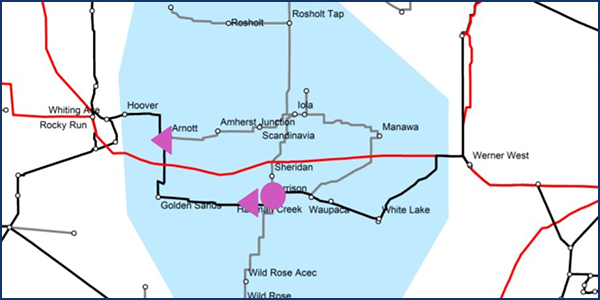By Amanda Durish Cook
MISO is poised to recommend its first-ever storage-as-transmission project to ease reliability issues in central Wisconsin, though the RTO doesn’t yet have rules to govern the project’s operation.
The RTO last week said it reviewed American Transmission Co.’s Waupaca area energy storage project against an alternative wires solution also submitted by the company. MISO concluded that while both projects improved reliability, a comparison of life cycle costs proved the storage project more cost-effective. Consequently, the project is set to be included in MISO’s 2019 Transmission Expansion Plan (MTEP 19) for approval in early December.
The 2.5-MW/5-MWh battery project is expected to cost $8.1 million and be in service at the end of 2021. ATC’s alternative 115-kV double circuit rebuild would have cost $11.3 million.
MISO said its preliminary recommendation is dependent on MISO Firming Up 1st SATA Ruleset.)
“There’s a big asterisk on” the project, MISO expansion planner James Slegers told stakeholders during a conference call Friday.
ATC plans to automate the storage facility, which will be triggered only on a post-contingency basis. ATC’s Jim Hodgson said costs of battery degradation are all included in the company’s estimated operations and maintenance costs and based on “the best available information.” The storage project also includes two new capacitors.
The company doesn’t expect the battery to be used often but notes it would have to cycle daily to keep in good condition. ATC is working off the assumption that the battery will last 20 years. The company also expects no public impact on rights of way. (See MTEP 19 Could Yield First MISO SATA Project.)
“First and foremost, it’s a reliability asset,” ATC’s Bob McKee told MISO and stakeholders.
ATC’s Waupaca area contains a local 69-kV system supported by a nearby multi-segment 115/138-kV transmission line. The area is at risk of voltage collapse if it experiences a double contingency or outage in conjunction with prior maintenance. When both ends of the 115/138-kV supply line are out of service, the system cannot sustain local loads at certain levels, Slegers said.
ATC currently uses an operating guide to open line segments to serve load radially on the 69-kV system after load levels reach a certain point and after a first outage. While the operating guide allows loads to be served after a second contingency, it places up to 114 MW of load at risk of disconnection, according to MISO. The battery is designed to operate after a second contingency.
MISO Manager of Expansion Planning Lynn Hecker said the RTO has worked closely with ATC to understand the operation of the battery and the maintenance costs.
RTO staff said the battery wouldn’t negatively impact the dispatch of the four nearby generation projects finishing the final phase of the generator interconnection queue. However, MISO hasn’t yet determined the network upgrades the projects might require because the projects entered the definitive planning phase in spring 2018.
MISO will post a draft MTEP 19 report on Sept. 16. So far, the RTO is positioned to recommend 529 new projects at $4.4 billion. The newest estimate is higher than those released in spring. (See MTEP 19 Revealing High Price Tag.) If approved, this year’s buildout package will be MISO’s most expensive. Last year, the RTO cleared a $3.3 billion, 442-project MTEP 18.




